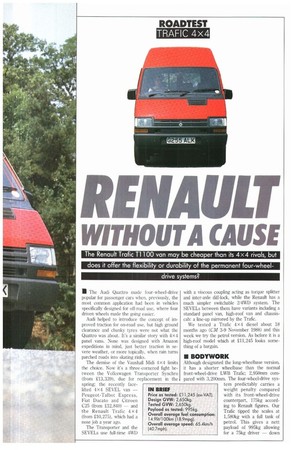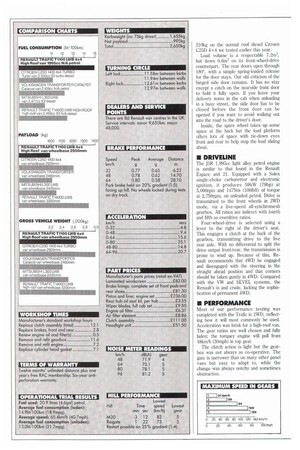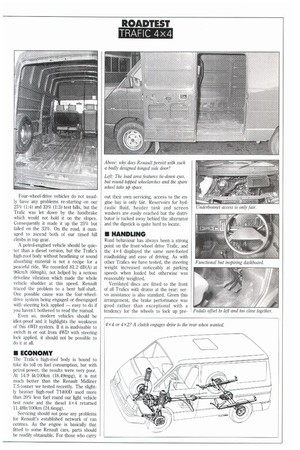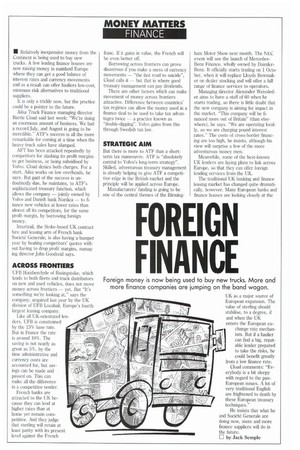RENAULT
Page 33

Page 34

Page 35

Page 36

Page 37

If you've noticed an error in this article please click here to report it so we can fix it.
WITHOUT A CAUSE
• The Audi Quattro made four-wheel-drive popular for passenger cars when, previously, the most common application had been in vehicles specifically designed for off-road use, where four driven wheels made the going easier.
Audi helped to introduce the concept of improved traction for on-road use, but high ground clearance and chunky tyres were not what the Quattro was about. It's a similar story with 4x4 panel vans. None was designed with Amazon expeditions in mind, just better traction in severe weather, or more topically, when rain turns parched roads into skating rinks.
The demise of the Vauxhall Midi 4x4 limits the choice. Now it's a three-cornered fight between the Volkswagen Transporter Synchro (from .13,339), due for replacement in the spring; the recently face lifted 4x4 SEVEL van — Peugeot-Talbot Express, Fiat Ducato and Citroen C25 (from .212,840) — and the Renault Indic 4x4 (from 10,275), which had a nose job a year ago.
The Transporter and the SEVELs use full-time 4W1) with a viscous coupling acting as torque splitter and inter-axle diff-lock, while the Renault has a much simpler switchable 2/4WD system. The SEVELs between them have variants including a standard panel van, high-roof van and chassiscab: a line-up mirrored by the Trafic.
We tested a Trafic 4X4 diesel about 18 months ago (CM 3-9 November 1988) and this week we try the petrol version. As before it is a high-roof model which at 211,245 looks something of a bargain.
Although designated the long-wheelbase version, it has a shorter wheelbase than the normal front-wheel-drive LWB Trafic; 2,950mm compared with 3,200mm. The four-wheel-drive system predictably carries a weight penalty compared with its front-wheel-drive counterpart, 175kg according to Renault figures. Our Trafic tipped the scales at 1,580kg with a full tank of petrol. This gives a nett payload of 995kg allowing for a 75kg driver — down 210kg on the normal roof diesel Citroen C25D 4x4 we tested earlier this year.
Load volume is a respectable 7.2m3, but down 0.6m3 on its front-wheel-drive counterpart. The rear doors open through 180°, with a simple spring-loaded release for the door stays. Our old criticism of the hinged side door remains. It has no stay except a catch on the nearside front door to hold it fully open. If you leave your delivery notes in the cab when unloading in a busy street, the side door has to be closed before the front door can be opened if you want to avoid walking out into the road to the driver's door.
Inside, the spare wheel takes up some space at the back but the load platform offers lots of space with tie-down eyes front and rear to help stop the load sliding about.
The J5R I,995cc light alloy petrol engine is similar to that found in the Renault Espace and 21. Equipped with a Solex single-choke carburettor and electronic ignition, it produces 59kW (79hp) at 5,000rpm and 147Nm (108Ibft) of torque at 2,750rpm, on unleaded petrol. Drive is transmitted to the front wheels in 2WD mode, via a five-speed all-synchromesh gearbox. All ratios are indirect with fourth and fifth as overdrive ratios.
Four-wheel-drive is selected using a lever to the right of the driver's seat. This engages a clutch at the back of the gearbox, transmitting drive to the live rear axle. With no differential to split the drive output front/rear, the transmission is prone to wind up. Because of this, Renault recommends that 4WD be engaged and disengaged with the steering in the straight ahead position and that corners should be taken gently in 4WD. Compared with the VW and SEVEL systems, the Renault's is and crude, lacking the sophistication of permanent 4W1), Most of our performance testing was completed with the Trafic in 2WD, reflecting how it will most commonly be used. Acceleration was brisk for a high-roof van. The gear ratios are well chosen and fully laden; the torquey engine will pull from 48Iun/h (30mph) in top gear.
The clutch action is light but the gearbox was not always as co-operative. The gate is narrower than on many other panel vans but easy to adapt to, while the change was always notchy and sometimes obstructive. Four-wheel-drive vehicles do not usually have any problems re-starting on our 25% (1:4) and 33% (1:3) test hills, but the Trafic was let down by the handbrake which would not hold it on the slopes. Consequently it made it up the 25% but failed on the 33%. On the road, it managed to ascend both of our timed hill climbs in top gear.
A petrol-engined vehicle should be quieter than a diesel version, but the Trafic's high-roof body without headlining or sound absorbing material is not a recipe for a peaceful ride. We recorded 81.2 dB(A) at 96km/h (60mph), not helped by a serious driveline vibration which made the whole vehicle shudder at this speed. Renault traced the problem to a bent half-shaft. One possible cause was the four-wheeldrive system being engaged or disengaged with steering lock applied — easy to do if you haven't bothered to read the manual.
Even so, modern vehicles should be idiot-proof and it highlights the weakness of this 4WD system. If it is inadvisable to switch in or out from 4WD with steering lock applied, it should not be possible to do it at all.
The Trafic's high-roof body is bound to take its toll on fuel consumption, but with petrol power, the results were very poor. At 14.9 lit/100km (18.49mpg), it is not much better than the Renault Midliner 7.5-tonner we tested recently. The slightly heavier high-roof T1400D used more than 20% less fuel round our light vehicle test route and the diesel 4x4 returned 11. 481it/100km (24.6mpg).
Servicing should not pose any problems for Renault's established network of van centres. As the engine is basically that fitted to some Renault cars, parts should be readily obtainable. For those who carry Left: The load area features tie-down eyes, but round-topped wheelarches and the spare wheel take up space.
out their own servicing, access to the engine bay is only fair. Reservoirs for hydraulic fluid, header tank and screen washers are easily reached but the distributor is tucked away behind the alternator and the dipstick is quite hard to locate.
Road behaviour has always been a strong point on the front-wheel drive Trafic, and the 4 >(4 displayed the same sure-footed roadholding and ease of driving. As with other Trafics we have tested, the steering weight increased noticeably at parking speeds when loaded but otherwise was reasonably weighted.
Ventilated discs are fitted to the front of all Trafics with drums at the rear: servo assistance is also standard. Given this arrangement, the brake performance was good rather than exceptional with a tendency for the wheels to lock up pre maturely. In our panic-stop testing from both 48km/h (30mph) and 64km/h (40mph), all four wheels locked up and the Renault veered to the right, accompanied by clouds of tyre smoke from 64km/h. A change of disc pad material might ease the locking tendency. Despite the high-roof body, the Trafic always felt stable with relatively little wind buffeting from passing vehicles in motorway driving.
Renault suggests that four-wheel-drive is only engaged in adverse weather or on poor surfaces. We took the Trafic to the track where we usually test off-road vehicles. Unfortunately conditions were dry and dusty so it was impossible to assess the Trafic's mud-plugging abilities. Its limiting factors for off-road use, however, are its restricted ground clearance and tyres, which, although wider in section than on the FWD Trafic, are still road tyres. Like the other 4x4 panel vans, it also lacks a low gear ratio option, emphasising that the Trafic is not designed for serious off-road use.
Uninspired is the fairest thing that can be said about the Trafic interior. Little thought appears to have been given to the
lot of the van driver. A ST,1 I cubby-hole in the dash on the passen,;( r side and a door pocket for the drivel are all the stowage offered for the maps, delivery notes, pens and the other paraphernalia essential for the job.
Seating in French cars has traditionally been among the best in terms of ergonomics but Trafic drivers are apparently a different shape from other mortals.
The seat seems to have had only one design criterion: to stop the driver from sitting on the floor. It offers no support in all the vital places and simply sags when sat on. This is combined with a peculiar driving position. The footwells intrude into the front floor space and the pedals are offset to the left and too close together for wide feet: not surprisingly long journeys are uncomfortable.
Controls and instruments are fairly standard with the major controls on the column' stalks. It all looks flimsy though and finish could be to a higher standard.
The Trafic's fresh air ventilation system is very good, providing a strong flow from the large face-level vents without recourse to the three-speed fan. All-round visibility is good thanks to the generous glass area and door mirrors. The question over the 4x4 must be: "Is it worth the extra pennies and the decreased payload comparedwith its 4 x 2 counterpart?" In a recent group test we pitted two 4x4 pickups against two 4x2s with limited slip differentials. Like the Trafic 4x4, the two 4x2s were not designed for serious off-road use, but for use primarily on-road with occasional forays up tracks, we decided they would be quite adequate.
So it is with the Trafic 4x4. A limited slip differential would be cheaper, lighter and do all that is required of the 4 x4. It would also be less vulnerable to the kind of damage inflicted on one of our test vehicle's front half-shafts. True, the Trafic is cheaper than any of its 4x4 rivals, but its crude simplicity does not offer the flexibility or durability of the permanent fourwheel-drive systems used on the SEVEL and VW vans. By comparison, the Renault system looks like a half-hearted attempt to cash in on the 4x4 boom. Perhaps the Regie could have spent its money better on a more comprehensive facelift a year ago which also dealt with some of the Trafic's enduring faults.
Dby John Kendall • Relatively inexpensive money from the Continent is being used to buy new trucks. A few leading finance houses are now raising money in mainland Europe where they can get a good balance of interest rates and currency movements and as a result can offer hauliers low-cost, minimum risk alternatives to traditional suppliers.
It is only a trickle now, but the practice could be a pointer to the future.
Ailsa Truck Finance managing director Barrie Cload said last week: "We're doing an enormous amount of business. We had a record July, and August is going to be incredible." ATFs success is all the more remarkable for coming at a time when the heavy truck sales have slumped.
AFT has been attacked repeatedly by competitors for slashing its profit margins to get business, or being subsidised by Volvo. Cload denies both charges. For a start, Ailsa works on low overheads, he says. But part of the success is undoubtedly due, he maintains, to ATF's sophisticated treasury function, which allows the company — jointly owned by Volvo and Danish bank Nordica — to finance new vehicles at lower rates than almost all its competitors, for the same profit margin, by borrowing foreign money.
Intertrail, the Stoke-based UK contract hire and leasing arm of French bank Societe Generale, is also having a bumper year by beating competitors' quotes without having to drop profit margins, managing director John Goodreid says. franc. If it gains in value, the French will be even better off.
Borrowing across frontiers can prove disastrous if you make a mess of currency movements — "the fast road to suicide", Cload calls it — but that is where good treasury management can pay dividends.
There are other factors which can make movement of money across frontiers attractive. Difference between countries' tax regimes can allow the money used in a finance deal to be used to take tax advantages twice — a practice known as "double-dipping". Volvo gains from this through Swedish tax law.
But there is more to ATF than a shortterm tax maneouvre. ATF is "absolutely central to Volvo's long-term strategy". Skilled, adventurous treasury management is already helping to give ATF a competitive edge in the British market and the principle will be applied across Europe.
Manufacturers' funding is going to be one of the central themes of the Binning
ham Motor Show next month. The NEC event will see the launch of MercedesBenz Finance, wholly owned by DaimlerBenz. It officially starts trading on 1 October, when it will replace Lloyds Bowmaker on dealer stocking and will offer a full range of finance services to operators.
Managing director Alexander Weissleder aims to have a staff of 60 when he starts trading, so there is little doubt that the new company is aiming for impact in the market. "This company will be financed more out of Britain" (than elsewhere), he says. "We are operating locally, so we are charging pound interest rates." The costs of cross-border financing are too high, he insists, although his view will surprise a few of the more adventurous money men.
Meanwhile, some of the best-known UK lenders are laying plans to link across Europe, so that they can offer foreign lending services from the UK.
The traditional UK banking and finance leasing market has changed quite dramatically, however. Many European banks and finance houses are looking closely at the
















































































